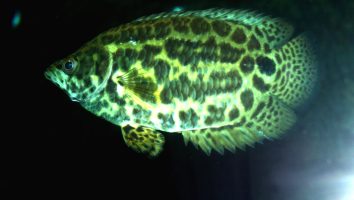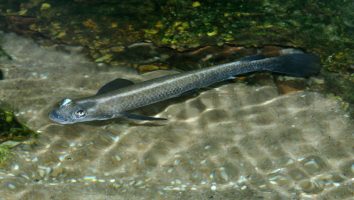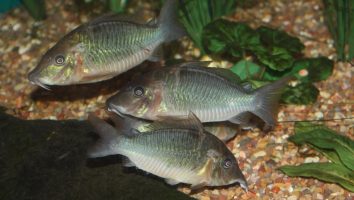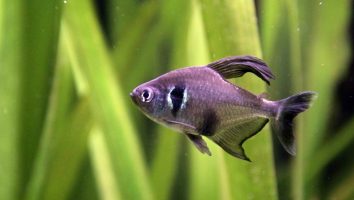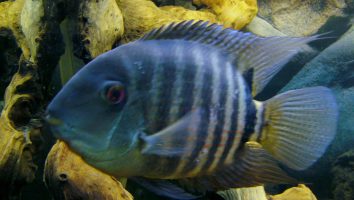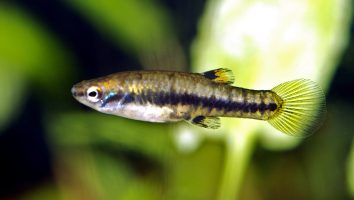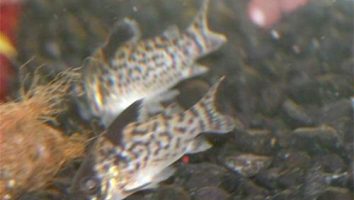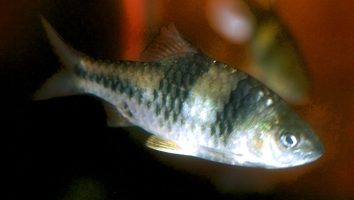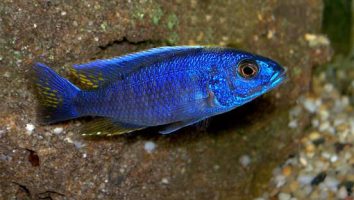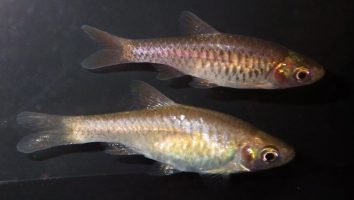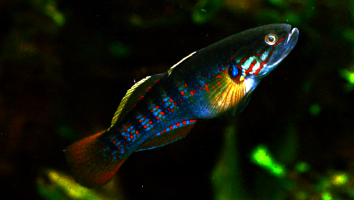The Dwarf flag cichlid is a beautiful freshwater fish that is perfect for beginner aquarists. They are relatively easy to care for and are very peaceful, making them a great addition to any community tank.
This guide will teach you everything you need to know about Dwarf flag cichlid care. You’ll learn about their diet, size, lifespan, and more!
Table of contents
Species overview
The Dwarf Flag cichlid (Aequidens tetramerus) is a beautiful freshwater fish that’s native to Guyana, Suriname, and French Guiana.
They are found in slow-moving rivers and streams with a sandy bottom and plenty of plants and vegetation. This is something to keep in mind when setting up their tank because they will need a sandy substrate and plenty of plants to hide in.
Dwarf flag cichlids are peaceful fish but can be territorial with their own species. It’s best to keep them in pairs or groups of odd numbers so that they don’t start fighting.
These fish are popular in the aquarium scene because of their beautiful colors and patterns. They are also relatively easy to care for, which makes them a good choice for beginner fishkeepers.
Appearance
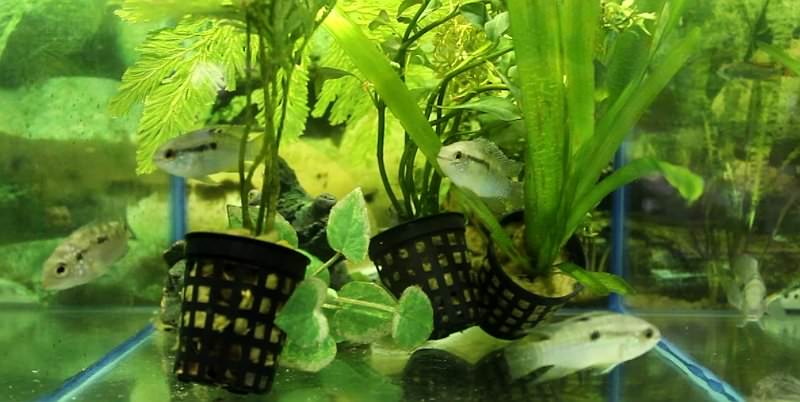
The Dwarf flag cichlid is a beautiful freshwater fish that has a very distinct color pattern. The base color of the fish is a deep navy blue.
On their dorsal half (from head to tail), there is a very thin yellow stripe. This stripe is broken up into a few sections by small navy blue spots. These spots are also present on the caudal and anal fins.
The pectoral and ventral fins are both a solid yellow. This can make them look like they’re wearing little life jackets!
The face of the Dwarf flag cichlid is where things start to get really interesting. They have two very large eyes that almost take up the entire top half of their head.
On the bottom half of their head, there is a large mouth that curves down slightly. This mouth is full of tiny little teeth that are perfect for eating small insects and crustaceans.
The Dwarf flag cichlid is a small fish that only grows to be about 3-4 inches (7.5-10 cm) in length.
Lifespan
5 – 7 years
Size
Dwarf flag cichlids only grow to be about 2.5 inches in length when fully mature.
Tank
Tank Size
The minimum tank size for a dwarf flag cichlid is 10 gallons. If you want to keep more than one of these fish in the same tank, you’ll need to add 5 gallons for each additional fish.
This is one of the smaller freshwater fish that are available and as such, doesn’t need a ton of space to roam. However, they are still active fish and will appreciate a little extra room to move around.
Water Parameters
The dwarf flag cichlid is a freshwater fish that’s native to the streams and rivers of Central America. In the wild, these fish prefer to live in areas with little to no current and plenty of hiding spots.
That means the water is typically on the calm side with a neutral to slightly alkaline pH.
To replicate these conditions in your home aquarium, aim for the following water parameters.
- Water temperature: 72 to 82 degrees Fahrenheit
- pH levels: 6.8 to 7.6
- Water hardness: 10 to 20 dGH
- Alkalinity Levels: 4 to 8 dKH
What To Put In Their Tank
When it comes to setting up the interior of a dwarf flag cichlid tank there are a few key things you need to remember.
First and foremost, these fish are diggers. They’re going to root around in the substrate looking for food, so you need to make sure it’s something soft. Sand or a very fine gravel is ideal.
Second, these fish like to have a lot of places to hide. This can be in the form of plants, rocks, or even driftwood. The more cover you can provide the better.
Third, these fish are known to be a little aggressive. It’s important to give them plenty of space to avoid any potential conflict. A good rule of thumb is to give each fish at least 10 gallons of space.
Fourth, these fish are known to be jumpers. It’s important to have a tight fitting lid on their tank to avoid any accidents.
Last but not least, these fish are sensitive to water quality. It’s important to have a good filter and to do regular water changes to keep the inside of their habitat clean.
Common Diseases
Unfortunately, the Dwarf flag cichlid is not a very hardy fish. They are known to be quite sensitive to water conditions and can easily fall ill if the tank isn’t up to par.
The most common disease that affects this species is ich. This is a parasite that can quickly take over your fish’s body and cause serious health problems.
The most obvious sign of ich is the presence of white spots on the body, fins, and gills of your fish. If you notice this, it’s important to act fast and begin treatment immediately.
Other potential diseases include hole-in-the-head, velvet, and bacterial infections. All of these can be quite serious and even fatal if left untreated.
As always, the best way to prevent your fish from getting sick is to maintain the quality of the water in their tank. A tank with clean and stable water conditions is always the best way to keep your fish healthy and happy.
Behavior & Temperament
The Dwarf flag cichlid is a peaceful fish that is perfect for community tanks. They are not known to be aggressive and will typically get along with other tank mates.
One thing to keep in mind is that Dwarf flag cichlids are known to be jumpers. So, if you have an open top tank, it’s important to make sure that it is covered.
These cichlids are relatively active fish. They will often swim around the tank and explore their surroundings. When they are not swimming, they like to hide in caves or other hiding spots.
Dwarf flag cichlids are also known to be good parents. If you decide to breed them, the female will lay her eggs in a cave or other hidden spot. Once the eggs hatch, the fry will be cared for by both parents.
Tank Mates
As with most cichlids, the dwarf flag cichlid can be aggressive. They’re not as bad as some other species, but they can still be a handful.
This is especially true when it comes to tank mates.
The good news is that the dwarf flag cichlid is relatively small. As a result, they’re not a threat to most fish.
In fact, they’re more likely to get bullied by larger tank mates. This is something to keep in mind when stocking your tank.
With that said, here are some compatible tank mates for the dwarf flag cichlid:
- Angels
- Discus
- Tetras
- Rainbows
- Gouramis
- Plecos
- Corydoras
Breeding
Dwarf flag cichlids are mouth-brooders, which means the female will carry the eggs in her mouth until they hatch. This protects them from getting eaten by other fish or getting caught in the filter.
The process starts when the female lays her eggs in a cave or some other hidden spot. Once she’s laid them, the male will fertilize them.
Then, the female will scoop them up in her mouth and carry them around until they hatch. This usually takes about two weeks.
Once the fry have hatched, the female will spit them out into the open. At this point, you can start feeding them baby brine shrimp or crushed-up flake food.
Make sure to remove the adults from the tank once the fry have hatched. They have a tendency to eat their young!
Conclusion
Dwarf flag cichlid care is not difficult, but there are a few things you need to be aware of.
First, these fish are very active and need plenty of space to swim. They also prefer to be in groups, so we recommend getting at least six of them.
Second, they’re known to be aggressive, so be sure to choose tank mates carefully. Avoid fish that are similar in size and shape, as well as fish that are known to be peaceful.
Third, they’re also known to be jumpers, so be sure to have a tight-fitting lid on your tank.
Other than that, they’re not too difficult to take care of. Just be sure to do your research and be prepared before adding them to your tank!

